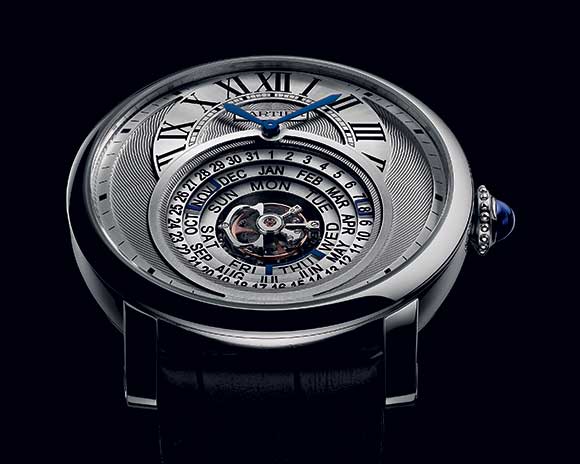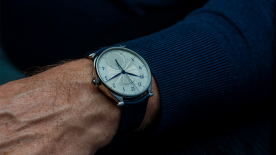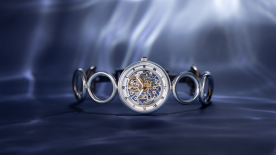Worldtempus: Do you feel at home as a woman in a man’s world?
Carole Forestier: There are a lot of women in the watch industry, in the workshops where you need patience and you need to be able to work on a very small scale. But it’s true that at the purely technical level, there are not many women.
How did you get involved in the watch industry?
I didn’t get involved in it, I was born into a family of watchmakers. My father, my mother and my brother were all watchmakers. I’m not Swiss, I was born in Paris but my parents had a restoration workshop and I lived in the family workshop. Little by little I started dismantling movements. My brother was more interested in making them work, but I wanted to take them apart to see how they worked – much to my father’s despair!
Once I had understood how they worked, I wasn’t very keen on putting them back together again. After disassembling movements up to the level of minute repeaters and reading a few books, I acquired a passion for watchmaking without really noticing.
As a teenager I remember that my friends were big fans of the great singers of the time, such as Michael Jackson, but I was a fan of the great watchmakers, so I would queue at the Champs-Elysées for the Belles Montres show to get the autograph of Daniel Roth, for example.
So your dream became a reality?
I asked my father if I could go to a watchmaking school and he told me that if I wanted to do that then I had to go to Switzerland. So I ended up in La Chaux-de-Fonds at the age of 16 and I did my watchmaking diploma at the school there. I never really returned to Paris because there aren’t any watchmaking factories there, so I started my career in La Chaux-de-Fonds and I’ve been there ever since.
Is it purely by coincidence then that you work for Cartier, a French brand?
Yes, at the time Cartier was looking for someone to work on movement development. But for someone working on the technical side of things it was not necessarily the first brand that would spring to mind. Cartier was known for its jewellery and they chased me for two years. Once I understood their ambitions I realised it was a great opportunity. Starting from a blank sheet of paper and managing to create all this for such a big brand is something you don’t do twice in your life.
Is there such a thing as a typical day’s work for you?
We have a big team, with 35 people working on movement development, most of them engineers. There are sub-teams with specialists in different areas, such as our base movement 1904 or high-end movements and the Poinçon de Genève movements, where you need to take into account the criteria right from the start. So I work with all these teams and my favourite time is when I do development reviews and we see the virtual movement on the screen and can go into details.

There is a great attention to detail in the design of your movements and watches, for example in the revolutionary configuration of your perpetual calendar. Is this a reflection of your involvement?
The beauty of working at Cartier is that product briefs are not written from a marketing standpoint. They are born from a common reflection between designers and movement developers. We always try to ask ourselves what we can improve. Taking the example of the Astrocalendaire, we asked ourselves what was problematic with current perpetual calendars. There was the risk of damaging the movement and the confusion for the customer with all the corrector pushers. So in the development brief we said we would try to find new solutions to improve this and come up with something new and useful.
How do you determine when innovations seen in your ID unique pieces can be used in the Cartier watch collection?
This is the process of industrialisation and it’s one of the longest processes. The ID models use totally new materials and technologies. Sometimes when we experiment with them we end up at a dead end, so we have to go back and start again. It’s something that is difficult to plan. It’s not a classic product development.
But you have some deadlines, like the SIHH, that you cannot miss…
Yes, of course. There is marketing and then there is reality. At a certain point we have to take the marketing strategy into account, but the marketing team is intelligent enough to know that the ideal scenario is not always possible and we have to find a compromise. But it is the technology that leads the way, that is the reality.
Do you have a favourite area among all the different spheres of your work?
What I enjoy and what I think we are good at is that, because we are quite new in watchmaking at Cartier, we can look at things with a fresh approach. This is what makes us different from others today. You have to see this as an advantage. We can look at things people have been doing for centuries and ask ourselves whether there is a better way of doing it.
Is it important for you to come to the SIAR in Mexico?
It’s extremely important. It gives me an overview of what’s going on in the industry. When you are stuck in the factory every day, it’s important to get out and about. The customer’s viewpoint is often different to those of us working in the industry and it’s important to see how our watches are received. When the first link in the chain meets the last, the customer, it’s a magical moment – for them as well as us.





